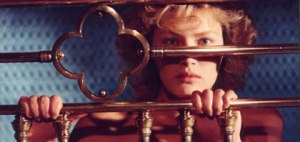I waited a long time to see one of the difficult-to-find films directed by French author-filmmaker Alain Robbe-Grillet, so I was excited to finally watch La belle captive, the 1983 film adaptation of his own novel by the same name. A fusion of Robbe-Grillet’s groundbreaking nouveau roman narrative techniques and René Magritte’s paintings (the original novel is illustrated with some 77 paintings by the surrealist master), Robbe-Grillet the director is obviously attempting a visual tone drawn directly from the famed Belgian surrealist―enigmatic, haunting, and vaguely, indefinably disturbing―but unfortunately ends up with a rather silly concoction of metaphysical pronouncements and rather insubstantially airy concoction of archetypal images and figures. One can sense a desire to tap into a mythic quality in the film’s vampiric ghosts, fetish figures, detective film overtones, erotic interludes, and invocations of sadism, but it all plays like an outlandishly “arty” (and now amusingly dated) Emmanuelle film, almost evoking a soft-core porn parody of Last Year at Marienbad, whose Oscar-nominated screenplay remains Robbe-Grillet’s most enduring and well known cinematic achievement.
That’s not to say that La belle captive is completely without merit. Considering the character she plays–some kind of mysterious combination of angel, ghost and vampire–the lovely Gabrielle Lazure makes the most of a figure that functions as little more than a male erotic fantasy; leather-clad, motorcycle-riding Cyrielle Clair cuts a striking figure, but is given even less to do than Lazure, and becomes little more than an object of fetishization.  The film’s closed off, artificial atmosphere does manage to conjure up a sense of languid, erotically overheated hypnosis and is the film’s primarily source of merit, though the dream-within-a-dream-within-a-dream structure eventually become oppressive. When it comes down to it, I found a lot of words and color and images but very little of the poetry I expected. A disappointment, though I remain intrigued by Robbe-Grillet’s overall aesthetic project, and remain eager to further explore this iconoclastic figure’s work.
The film’s closed off, artificial atmosphere does manage to conjure up a sense of languid, erotically overheated hypnosis and is the film’s primarily source of merit, though the dream-within-a-dream-within-a-dream structure eventually become oppressive. When it comes down to it, I found a lot of words and color and images but very little of the poetry I expected. A disappointment, though I remain intrigued by Robbe-Grillet’s overall aesthetic project, and remain eager to further explore this iconoclastic figure’s work.

